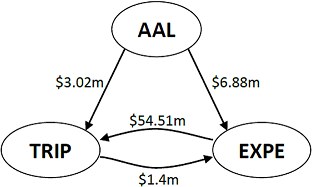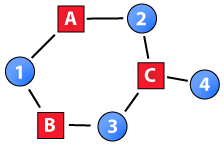Posts filed under ‘Articles’
The added benefit of network data: Assessing impact of suppliers and buyers on CDS spreads
 Networks has the potential to increase the explanatory power of models. The content of this post, and accompanying paper, quantifies the size of this effect for predicting the financial health of companies. It is my hope that it can help drive more research into networks and enable more organizations to develop better models and understand interdependencies to a greater extent.
Networks has the potential to increase the explanatory power of models. The content of this post, and accompanying paper, quantifies the size of this effect for predicting the financial health of companies. It is my hope that it can help drive more research into networks and enable more organizations to develop better models and understand interdependencies to a greater extent.
Companies do not operate in a vacuum. As companies move towards an increasingly specialized production function and their reach is becoming truly global, their aptitude in managing and shaping their inter-organizational network is a determining factor in measuring their health. Current models of company financial health often lack variables explaining the inter-organizational network, and as such, assume that (1) all networks are the same and (2) the performance of partners do not impact companies. This paper aims to be a first step in the direction of removing these assumptions. Specifically, the impact is illustrated by examining the effects of customer and supplier concentrations and partners’ credit risk on credit-default swap (CDS) spreads while controlling for credit risk and size. We rely upon supply-chain data from Bloomberg that provides insight into companies’ relationships. The empirical results show that a well diversified customer network lowers CDS spread, while having stable partners with low default probabilities increase spreads. The latter result suggests that successful companies do not focus on building a stable eco-system around themselves, but instead focus on their own profit maximization at the cost of the financial health of their suppliers’ and customers’. At a more general level, the results indicate the importance of considering the inter-organizational networks, and highlight the value of including network variables in credit risk models.
Continue Reading February 23, 2016 at 1:20 am Leave a comment
Securely using R and RStudio on Amazon’s EC2
 R is a great tool for analysing data with an intuitive and interactive programming language. There are a number of limitations with an interactive programming language compared to compiled languages, such as higher memory and processing requirements. One way of overcoming these requirements is to use cloud computing, such as Amazon EC2. The Bioconductor group has an Amazon Machine Image with the latest version of R and RStudio; however, there is a major security hole in the default setup that allows others to “borrow” the resources you are paying for as well as being able to steal your data. This post highlights how to close this hole and securely use R and RStudio on Amazon EC2.
R is a great tool for analysing data with an intuitive and interactive programming language. There are a number of limitations with an interactive programming language compared to compiled languages, such as higher memory and processing requirements. One way of overcoming these requirements is to use cloud computing, such as Amazon EC2. The Bioconductor group has an Amazon Machine Image with the latest version of R and RStudio; however, there is a major security hole in the default setup that allows others to “borrow” the resources you are paying for as well as being able to steal your data. This post highlights how to close this hole and securely use R and RStudio on Amazon EC2.
Article: For the few not the many? The effects of affirmative action on presence, prominence, and social capital of women directors in Norway
 A paper called “For the few not the many? The effects of affirmative action on presence, prominence, and social capital of women directors in Norway” that I have co-authored will be published in the Scandinavian Journal of Management. Governments have implemented various affirmative action policies to address vertical sex segregation in organizations. A gender representation law was introduced in Norway, which required public limited companies’ boards to have at least 40 percent representation of each sex by 2008. This law acted as an external shock, and this paper aims to explore its effects. In particular, it explores the gender bias, the emergence and sex of prominent directors, and directors’ social capital. We utilize data from May 2002 to August 2009 to analyze these aspects. The implied intention of the law was to create a larger pool of women acting as directors on boards, and the law has had the effect of increasing the representation of women on boards. However, it has also created a small elite of women directors who rank among the top on a number of proxies of influence.
A paper called “For the few not the many? The effects of affirmative action on presence, prominence, and social capital of women directors in Norway” that I have co-authored will be published in the Scandinavian Journal of Management. Governments have implemented various affirmative action policies to address vertical sex segregation in organizations. A gender representation law was introduced in Norway, which required public limited companies’ boards to have at least 40 percent representation of each sex by 2008. This law acted as an external shock, and this paper aims to explore its effects. In particular, it explores the gender bias, the emergence and sex of prominent directors, and directors’ social capital. We utilize data from May 2002 to August 2009 to analyze these aspects. The implied intention of the law was to create a larger pool of women acting as directors on boards, and the law has had the effect of increasing the representation of women on boards. However, it has also created a small elite of women directors who rank among the top on a number of proxies of influence.
Continue Reading September 30, 2010 at 4:02 pm Leave a comment
Article: Node centrality in weighted networks: Generalizing degree and shortest paths
 A paper called “Node centrality in weighted networks: Generalizing degree and shortest paths” that I have co-authored will be published in Social Networks. Ties often have a strength naturally associated with them that differentiate them from each other. Tie strength has been operationalized as weights. A few network measures have been proposed for weighted networks, including three common measures of node centrality: degree, closeness, and betweenness. However, these generalizations have solely focused on tie weights, and not on the number of ties, which was the central component of the original measures. This paper proposes generalizations that combine both these aspects. We illustrate the benefits of this approach by applying one of them to Freeman’s EIES dataset.
A paper called “Node centrality in weighted networks: Generalizing degree and shortest paths” that I have co-authored will be published in Social Networks. Ties often have a strength naturally associated with them that differentiate them from each other. Tie strength has been operationalized as weights. A few network measures have been proposed for weighted networks, including three common measures of node centrality: degree, closeness, and betweenness. However, these generalizations have solely focused on tie weights, and not on the number of ties, which was the central component of the original measures. This paper proposes generalizations that combine both these aspects. We illustrate the benefits of this approach by applying one of them to Freeman’s EIES dataset.



 RSS feed
RSS feed